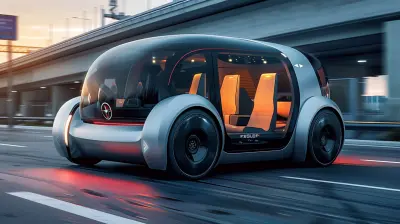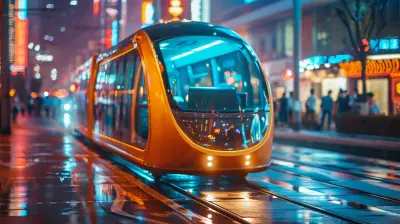Autonomous Vehicles and the Race for Zero Emissions
8 November 2025
The future is speeding toward us, and it’s riding in a self-driving electric vehicle. Autonomous vehicles (AVs) aren’t just cool sci-fi dreams anymore — they’re real, they’re here, and they’re evolving faster than most people imagine. But there’s more to this story than just robots driving cars. One of the biggest plots? The race to zero emissions. Yep, those driverless cars could be the secret weapon in our fight against climate change. Sounds exciting, doesn’t it?
Let’s peel back the layers on how autonomous vehicles are reshaping our roads and helping us breathe cleaner air.
What Are Autonomous Vehicles, Really?
Before we dive into their eco-credentials, let’s get one thing straight — what exactly are autonomous vehicles? In plain English, they’re cars that drive themselves. No hands on the wheel. No feet on the pedals. Using a mix of sensors, cameras, machine learning, and AI, they navigate roads, avoid obstacles, and follow traffic rules — ideally better than humans do.There are different levels of autonomy, from driver assistance (think cruise control) to full autonomy, where the car handles every part of the journey, no human needed. Companies like Tesla, Waymo, Cruise, and Apple are deep in this race and pouring billions into perfecting this tech.
Sounds futuristic? Well, that future is right around the corner.
The Environmental Problem on Four Wheels
Let’s not sugarcoat it — traditional cars have been one of the biggest contributors to greenhouse gas emissions. Think about this: transportation makes up nearly 29% of total emissions in the U.S., and the majority of that comes from personal vehicles. That’s a huge carbon footprint.Burning gasoline and diesel releases CO₂, nitrogen oxides, and other pollutants that dirty up the air and heat up the planet. It’s like having millions of tiny smokestacks on wheels.
So, the question isn’t just about getting from Point A to Point B anymore. It’s about how we get there without wrecking the climate along the way.
Are Autonomous Vehicles Actually Better for the Environment?
Here’s where things get interesting. The technology behind AVs could drastically reduce emissions — but only if we do it right. Here’s how:1. Optimized Driving = Fewer Emissions
Robots don’t have road rage. They don’t floor the gas, slam the brakes, or take inefficient routes. AVs drive with precision and consistency. That smooth, calculated driving means better fuel efficiency and less energy waste. When a car’s not constantly stopping and starting, it burns less fuel (or energy).2. Shared Mobility Reduces the Number of Cars
The vision for AVs isn’t just about replacing one car for one person. It’s about ride-sharing, carpooling, and even robo-taxis. In theory, one autonomous car could serve dozens of people throughout the day. Fewer cars on the road = fewer emissions. Simple math.3. Fleet Electrification is a Game-Changer
Most companies developing AVs are building them as electric vehicles (EVs). Think about a self-driving Tesla or a robo-taxi fleet powered entirely by green electricity. Combine autonomy with electrification, and you’ve got a double-whammy against pollution.
The EV and AV Combo: A Match Made in Eco-Heaven
Let’s get one thing straight: autonomous vehicles alone won’t solve climate change. But autonomous electric vehicles? Now we’re cooking with clean energy.EVs already produce far fewer emissions than gas-powered cars. Combine that with the optimized routes and efficient driving of AVs, and you’ve got an environmental powerhouse. This combo could be the golden ticket to a zero-emissions future — if cities and companies play their cards right.
Challenges in the Race for Zero Emissions
Not everything’s sunshine and rainbows. While the potential is huge, there are a few speed bumps in the road.1. High Energy Demands
Self-driving tech isn’t light on power. All those sensors, cameras, and AI processing? They suck up a lot of energy, even in EVs. If we’re not careful, the energy demands of AVs could eat into the emissions savings.2. Manufacturing Emissions
Building an autonomous electric vehicle is resource-heavy. The batteries, the sensors, the advanced materials — they all come with a carbon price tag. If we’re not sourcing materials sustainably and building with clean energy, we might just be shifting emissions from the tailpipe to the factory.3. Urban Sprawl and More Road Time
Here’s something weird to think about: if AVs make travel cheap and easy, people might choose to live farther from work, increasing urban sprawl. That could mean more time on the road and higher total emissions — unless those vehicles are part of a shared economy model.How Governments and Cities Can Keep the Green Promise
Policymakers have a huge role to play here. They can make or break the AV-EV revolution’s environmental impact. So what can they do?- Incentivize Electrification: Offer tax breaks, grants, or perks for electric autonomous vehicles.
- Invest in Clean Energy: Charging AVs with coal-powered electricity defeats the purpose. Green grids are critical.
- Encourage Shared Mobility: Don’t just swap one gas car for one AV. Promote shared services like robo-taxis and autonomous shuttles.
- Urban Planning: Design cities for fewer cars, more public transit, and accessible AV hubs.
Real-Life Players Pushing the Envelope
Let’s talk about who’s walking the walk.Tesla
Tesla’s crowd-favorite Full Self-Driving (FSD) feature is inching closer to true autonomy. Add their all-electric lineup, and they’re one of the loudest voices in the AV-zero emissions conversation.Waymo
Google’s Waymo is already operating autonomous ride-hailing services in parts of the U.S. And guess what? They’re using electric Chrysler Pacificas and Jaguar I-PACEs for their fleet.Cruise
Backed by GM, Cruise aims to launch a fully electric, fully autonomous ride-sharing service. They're focused on urban areas, and their goal is explicitly zero emissions.Zoox (Amazon)
Amazon’s Zoox is developing a futuristic, bi-directional electric robotaxi with no steering wheel. It’s like something out of "The Jetsons" — but grounded in reality.What the Future Could Look Like
Imagine this:You wake up. No stress about traffic or parking. You grab your phone, tap an app, and a sleek, electric, self-driving pod shows up at your door. It silently glides you to work while you sip your coffee and scroll your emails.
Meanwhile, the air is cleaner, the roads are quieter, and your city has more parks than parking lots. That’s not just a dream — it’s what the world could look like if we nail this.
But we’ve got to act fast and smart. Autonomous vehicles are a tool. It’s up to us to use them wisely. If we don’t, we risk creating a world with more convenience… but still choking on fumes.
AI + Clean Energy = Driverless Sustainability?
Let’s zoom out for a moment.Autonomous vehicles are part of a bigger movement — the blend of AI and clean tech. These two forces are reshaping everything from how we move, to how we power our lives. AVs are just one piece of the puzzle.
But they’re a big, shiny, powerful piece.
If we align the tech, the policies, and the culture, AVs can help drive us into a sustainable, zero-emissions future. But if we miss the mark or get greedy, we could end up in traffic jams on a hotter planet filled with more cars that just happen to not have drivers.
So yeah, the stakes? They’re pretty high.
Conclusion: Full Speed Toward Green Mobility
Autonomous vehicles aren’t just cool — they’re potentially climate-saving. But the tech alone won’t get us there. We need smart decisions, clean energy, and a shift in how we think about transportation.It’s not about having a fancier car. It’s about building a smarter, cleaner world. And AVs? They might just be the high-tech horses pulling us into that cleaner future.
Are you ready to hop in the passenger seat of this green revolution?
all images in this post were generated using AI tools
Category:
Autonomous VehiclesAuthor:

Kira Sanders
Discussion
rate this article
1 comments
Wade Kane
Just imagine: self-driving cars zooming past gas stations like they're in a game of 'hot potato!' At this rate, the only fumes we'll have left are from our laughter over their witty AI banter!
November 8, 2025 at 5:56 AM

Kira Sanders
Thanks for the amusing vision! The shift to autonomous, electric vehicles is indeed not just about reducing emissions but also transforming our driving experience.


